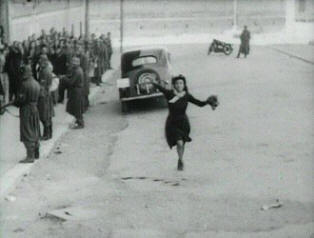Italian Neorealism
 Mussolini came to power in Italy in 1922 resulting in very strong censorship
of Italian media and the production of "white telephone" movies.
Mussolini came to power in Italy in 1922 resulting in very strong censorship
of Italian media and the production of "white telephone" movies.
After the end of the war, film makers and audiences wanted a politically engaged
cinema that told "the truth."
Neorealist movies tended to have minimal plot lines and focused around more around the politics and psychology of crisis. The films are bleak. Endings are never happy, but many provide a little hope.
Neorealist movies were very different from American movies of the same era. These latter were often adaptations of books and usually ended with the
triumph of the good guys or the marriage of the stars.
Next: key characteristics
 White telephone (Telefoni Bianchi) films were set among the upper classes. The white telephone was a symbol of luxury characteristic of the lives of the wealthy. The films were generally romances or comedies. Luigi Freddi, the head of the Fascist General Directorate of Cinematography promoted a "cinema of distraction." That is, rather than the direct political propaganda of the Soviet or Nazi cinema, Freddi believed that movies should be used to keep the population distracted and entertained. He was providing the "circuses" part of "Bread and Circuses." Some examples are T' Amero Sempre (1933) and La Signora Di Tutti (1934). The Neorealists reacting against this, wanted to create a authentic and engaged cinema.
White telephone (Telefoni Bianchi) films were set among the upper classes. The white telephone was a symbol of luxury characteristic of the lives of the wealthy. The films were generally romances or comedies. Luigi Freddi, the head of the Fascist General Directorate of Cinematography promoted a "cinema of distraction." That is, rather than the direct political propaganda of the Soviet or Nazi cinema, Freddi believed that movies should be used to keep the population distracted and entertained. He was providing the "circuses" part of "Bread and Circuses." Some examples are T' Amero Sempre (1933) and La Signora Di Tutti (1934). The Neorealists reacting against this, wanted to create a authentic and engaged cinema.
 Mussolini came to power in Italy in 1922 resulting in very strong censorship
of Italian media and the production of "white telephone" movies.
Mussolini came to power in Italy in 1922 resulting in very strong censorship
of Italian media and the production of "white telephone" movies. White telephone (
White telephone (